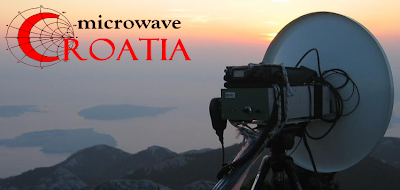The easiest way to get a descent local oscillator for the microwave bands is purchasing the synthesizer fabricated by the Elcom technologies Inc. Most of mine units are purchased through the E-bay from well know Israeli vendor. To be honest, I was not so lucky with that as most of the units are not working or not working properly. It is well written that the vendor does not guaranty that the units are working properly, so it is on us to decide to buy or to skip... From time to time there are some new units available, sealed, followed with the documentation. This is the way to go. True, the price is almost double but buying four units and having one descent is even more expensive :-)
Let say you get lucky and you have your unit in order, you will need the controller to run this brick. Most of the guys are using Dave - WW2R design. What yo need to know is that you have to multiply the required output synthesizer frequency by 3 and edit the ASM code just using the first 4 digits, compile the HEX and program the PIC 12F675. Plug the power and the lock LED should blink once and lighted. BINGO.
This happens if all is going by the book.
The first sign that something is going wrong may be a LED not locking the ON state. The first thing is to check if the math was ok. Let say you want to program the 11800 MHz frequency. 11800 x 3 = 35400
So you need to program the ASM two lines with the 3540. Of course, the Dave HW is supporting two frequencies, so program another convenient one.
Still not working?
Well, do not expect to have the units working out of the indicated range. Many guys are looking to have the DFS-1201 running on 12.023.333 MHz (for the 24GHz beacon) but mine experience is that the units can lock from 11.250-11.860 MHz, so even narrower than declared.
Surgery - getting a screwdriver (better a battery one :-)
You can always open the brick. If you are lazy to unscrew all those screws, check the picture:
Simple as beans soup :-) The VCO is running on 2.8-3.0 GHz. There is a buffer right after followed by the resistor splitter for the PLL and MMIC doubler 5.6-6 GHz. There is a high pass filter and another 6Ghz MMIC amplifier to provide enough power to drive the x2 multiplier diode. A long 12GHz filter then is followed by 2 stage FET amplifier. The total multiplication factor is 4. Clear ?
Guys owing the Alcatel White box 23GHz equipment needs the oscillator running on 5.9GHz. This is not so common surplus e-bay unit. DFS-1201 can do that ! All you need to do is to run the 6GHz signal from the amplifier just before the diode doubler to the output SMA connector with a peace of semirigid coax placed where the diode multiplier, 12GHz filter and 2 stage amplifier sits. All this multipliers and amplifiers (except tha last 12Ghz stage) are Sirenza S1 and S2 (ERA-1 and ERA-2 mmics) so you will have more than enough power for your White box 24Ghz transverter.
I did not play around the PLL side so much, but briefly, the reference oscillator is running on 100 MHz and heated as per above picture. The signal is then multiplied by x9 and filtered with two ceramic filters. Another mmic multiplier by x3 using INA10386 mmic followed by 2.7Ghz hairpin filter. This signal is then going to the mixer on one side and the signal from the VCO from the other side and we have the mixer output of 100-300 Mhz going to the lowpass filter and then after to the PLL. The complete picture of the digital part is here.
Most common problem is that the frequency is odd. Of course, aging of the crystal with the constant temperature is resulting to have the output frequency shifted (in my case 23khz @ 12Ghz). Just above the crystal there is a small part looking as the trimmer capacitor, so this may be re-tuned, I think so.
I had some other problem, when cold, the unit lock properly, but after some time when heated, if the unit is switched on/off I can not get the lock state and no output at all. This remain to be investigated.
On some DFS-1301 unit I can not get the lock state at all, even when cold. Checked the VCO control voltage from the charge pump and the 6V measured. It should be 5V. After playing around VCO transistor (marked 420) i manage to get the lock, VCO control voltage drop to 5V. After restarting the same problem.
This should be also investigated. And yes, to run the DFS-1301 from the Dave board, the output frequency should be multiplied by 2 or divided by 5. Funny math, you get the same first for digits :-) to program the ASM code.
So that's all for now, at least my DFS-1295 is working properly if nothing else :-)


.JPG)

.JPG)
.JPG)
.JPG)


.JPG)
